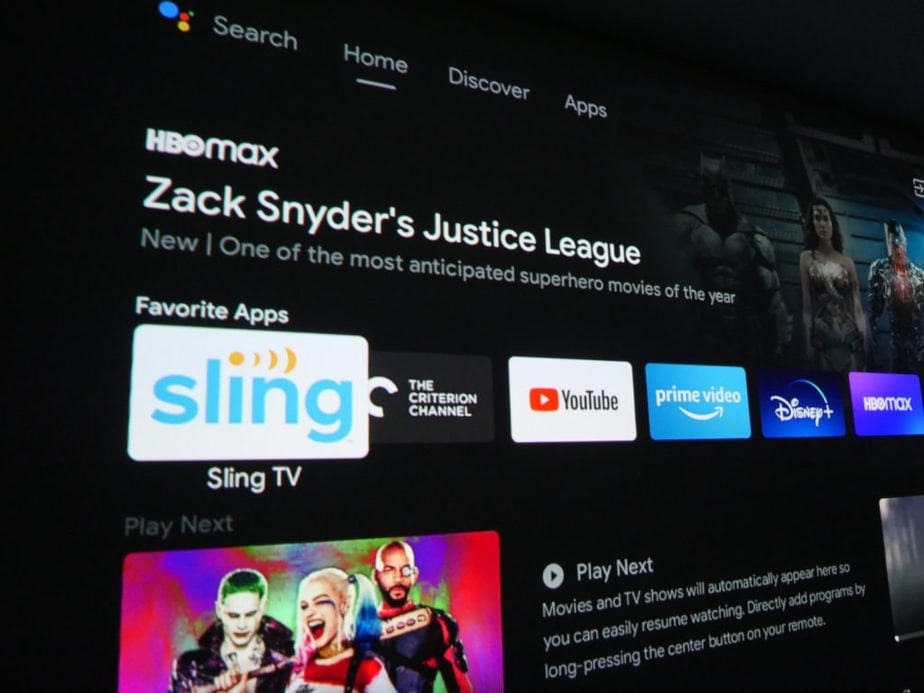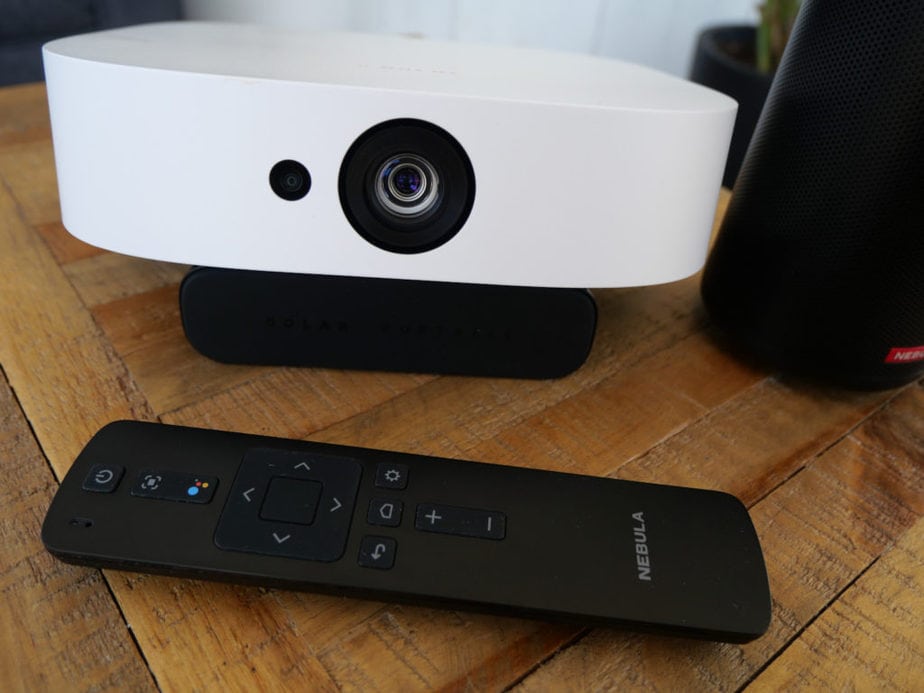Portable projectors now come as small as a pint glass. For the same price as a mid-range 4K TV, you can have an instant movie theater at the family camp, in a backyard or wherever there is extra wall space.
Anker has been at the forefront of this new generation of mid-tier portable projectors under its Nebula brand. One of its latest models, the Nebula Solar Portable, is a brighter and bolder sequel to the Nebula Capsule II, which was released in 2019.
In 2024, the Nebula Solar Portable is still a well-made projector; however, you should consider a newer model in the Anker lineup such as the Capsule 3.
The Solar Portable is a strong performer with streaming Amazon Prime Video, Disney+, Hulu, HBO Max and a number of other apps thanks to its Android TV software. Netflix requires an added step for streaming, but it’s an improvement over the Capsule II’s workaround.
The gaming chops on Solar Portable are remarkable, too. Instead of just Android games out of the Google Play Store, the Solar Portable has the Steam Link app, which allows you to play any PC game running within your home network. Under the remote and accessory settings, I paired a Bluetooth gamepad to play Steam games.
With any portable projector, the tradeoffs are obvious. The price for a decent home theater projector starts at about $1,500 and goes up from there.
Portable projectors now cost about half the price. But you won’t be getting the brightness of a home theater projector.
The Nebula Solar Portable was released alongside a sibling model called the Nebula Solar, which does not have a battery and only operates with an adapter. The Solar is slightly cheaper in price.
The Solar Portable has a square, flat body that measures a little over seven inches wide and long. It’s a departure from the “TV in a can” design that catapulted the Nebula Capsule series into a popular novelty.
Streaming with Android TV
The projector has Android TV for software. So you’re getting native support for most of the popular streaming apps out there, including Amazon Prime Video, Disney+, Hulu and ESPN.
You can watch Netflix on the projector. You just jump over to the Nebula app manager and launch it from there. I’ve been told by a representative from Anker that due to Netflix’s policies, the company only certifies devices with at least 1 million units in production.

Aside from a couple of extra clicks on my remote, I had no problem navigating Netflix, and the picture quality looked the same as other apps that I’ve used on the projector. I haven’t found a mini or portable projector yet that has a native Netflix app.
With Android TV software, you’re getting a similar experience as the NVIDIA Shield, or the new Google Chromecast. Apps and games come from the Google Play Store. The Solar Portable doesn’t have a full fledged Google TV interface. It comes with Android TV 9.0, but I did notice there are some recommendation features under the Discover tab that are similar to what you now see on Google TV.
Google Chromecast is built-in to the projector. You can use this for streaming apps on your phone or tablet. Or you can use it to cast your personal photos and videos.
I’m also a big fan of over-the-air TV. And the Android TV software gave me options for using my HDHomeRun tuner and Plex.
Gaming: Android and Steam Link
The gaming chops on the Nebula Solar are very good.
The internal storage is just over 4 GB, so you can download a few Android games from Google Play Store such as Beach Buggy Racing.
But the real gem is the Steam Link app.
Under the Bluetooth settings, I connected a GameSir T4 Pro gamepad that I bought a few years ago. My Steam account is on an Acer Predator laptop.
My download speed, according to SteamLink was just over 100 Mbps.
I played some pretty fast-paced games such as Mortal Kombat X and Injustice 2, and I didn’t have any lag or hang ups. The frame rate looked really good.
The hardware specs on Solar include a Quad Core A55 Chipset for a CPU and 2GB of RAM. The Wi-Fi is 802.11ac, so you can use a 2.4GHz or 5GHz band if you have a decent WiFi router that’s optimal for gaming.
Battery performance
The Solar Portable comes with a 20,000mAh / 3.7v battery, and charges with a USB C power bank.
The battery life on the Solar Portable was better than I expected. Anker says that it’s a three hour battery. In my testing, it was roughly 3 ½ hours over three times when I timed a full battery running down to empty.
The one caveat with the battery life (and I know a lot of people skip this step) is that before I use the projector for the first time, I plug it in and make sure the battery is charged 100 percent. If you don’t do that, you probably won’t have the best battery performance long term.
Picture Quality: HDR10 and 1080p
The HDR10 support on the Nebula Solar adds granular detail and color to faces and landscapes alike. The projector has 400 lumens. It’s twice the number of lumens of the Nebula Capsule II and Capsule Max. And it’s noticeable. But this is a projector that’s made for dark rooms — not daytime use with bright sunlight.
If you’re outdoors, you’ll want to start using the Solar at dusk. Indoors, you’ll want the room to be pretty dark. Pitch black is going to give you the best results.
You’re not limited to projecting your movie on a white wall or screen. Under settings, there are eight different color adjustments for colored walls or screens, including blue, green and even orange.
I tried this on a light blue wall in my living room, and the color accuracy was pretty on point. I really couldn’t notice that I was using a blue wall for my screen.
The wall in my office isn’t exactly white. It’s more of an eggshell. I didn’t make any adjustment for that.
There are three settings for color temperature. I thought the cool setting gave me the best overall picture, but I watched a number of shows and movies in normal setting and that looked good too. The warm setting looked like it had a little too much of a yellowish tint.
Overall, I’m pretty happy about the color accuracy.
Audio
Audio is the one area where I wish the projector was a little better.
There are two 3W speakers that support Dolby audio. The sound is satisfactory, but it lacks the depth and pop of the 8W speaker on the Nebula Capsule II.
The Solar has Bluetooth connectivity for both input and output. So I connected a Bose SoundLink Color II for a fuller audio experience.
Once the speaker is connected, it automatically powered on and connected again the next time I turned on the projector.
The fan noise is pretty low, but noticeable when you first power on the projector. You won’t hear it once the audio on your movie or TV show starts playing. That’s important because there’s nothing more distracting to me than a noisy fan when I’m trying to watch a movie.
Auto-focus and Setup
The auto-focus and automatic keystone correction are quick and work really well. I always like projectors that have those two features because it cuts down on your setup time, and you can start watching a movie or TV show a lot quicker.
Getting the picture in focus and at the right angle using manual dials isn’t terribly hard, but in my experience, it does take a little practice and effort to get just right. That matters if you’re someone who regularly re-located their projector to watch movies both indoors and outdoors.
The keystone correction adjusts both horizontally and vertically.
On the bottom of the projector, there is a hinge-style stand at the front of the projector. I used it some, and it worked fine, but preferred using the tripod mount more.
Not everything around my house is level, including the table in my office. Being able to adjust the horizontal angle was important to me, and that’s not something that you can address through keystone correction.
My distance from the walls was roughly 10 feet during testing.
The projected image was about 120” inches. You can also adjust the size of the image down to 70 percent under the “zoom” setting.
Nebula Solar Remote
The remote control feels good in the hand. It’s maybe about a centimeter longer than the remote with the Capsule II. The buttons have a nice rubber finish that’s soft to the touch. At the top of the remote there’s power. You can trigger autofocus and keystone correction below it.

This is the second projector I’ve tested with Google Assistant, and I’ve been using it a lot more than I expected. Searching for a particular movie, or a lineup of movies with a particular actor is really handy. You can look up a weather forecast and or an upcoming game with Google Assistant.
In the middle of the remote there’s a slightly different take on the wheel style button that you see on a lot of streaming remotes now.
Below that there’s a back button, one for the home screen and the settings button.
At the bottom there’s the volume control.
There are two things that stood out about the remote. The rubberized buttons definitely felt a little more premium than the harder plastic on the Capsule II remote.
The real litmus test — or seal of approval — was that the button layout felt intuitive because when I was in the dark using the projector, I wasn’t turning on a light searching for a particular button. I could figure it out pretty quickly.
Controls and ports: HDMI, USB-C
The Solar Portable has an HDMI port that you can use to use a different streaming device, or a gaming console. So if you want to hook up an XBox, Nintendo Switch or PlayStation console, you can do that.
The USB Type-C connection is used to recharge the battery. The USB port can be used for accessing other files. And there’s the power button.
There are two volume buttons on the top of the projector. The center button controls whether you’re in projector mode, or using the projector as just a Bluetooth speaker.
So is the Solar Portable a worthy successor to the Nebula Capsule II?
The Solar Portable is $599. That’s $20 more than the Capsule II.
But with the Solar you’re getting 200 lumens more of brightness, 1080p resolution with HDR10 support.
The tradeoff is that you’re getting a slightly larger projector instead of the more portable pint-shape size of the Capsule II.
Overall, I think the Anker has upped their game with the Nebula Solar Portable. The projector costs the same as a mid-range 4K TV or smartphone, and the performance is pretty great with streaming, and gaming.